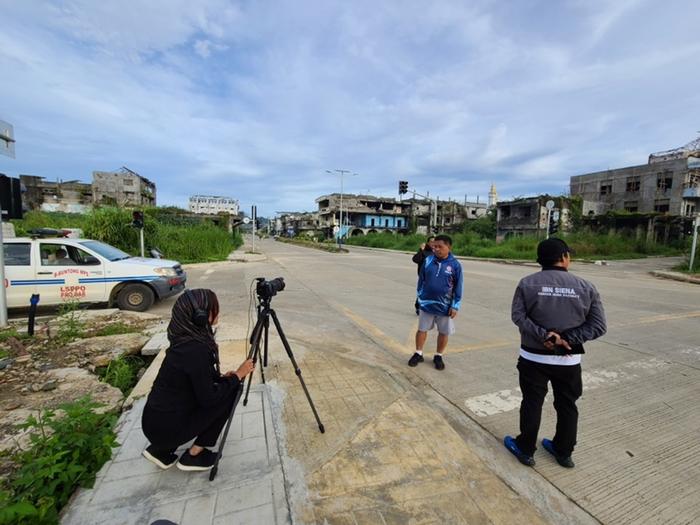Wars and conflicts leave devastating destruction in their wake. With so many conflicts now taking place in urban environments, scientists are studying how post-conflict peacebuilding happens in these urban settings. Dahlia Simangan, an associate professor at The IDEC Institute, Hiroshima University, has analyzed the case of Marawi, a city in the Philippines, to better understand the urban environment’s influence on post-siege reconstruction and peacebuilding. This study contributes to a more comprehensive understanding of peacebuilding by integrating conventional peacebuilding components and urban characteristics.

Credit: Dahlia Simangan, Hiroshima University
Wars and conflicts leave devastating destruction in their wake. With so many conflicts now taking place in urban environments, scientists are studying how post-conflict peacebuilding happens in these urban settings. Dahlia Simangan, an associate professor at The IDEC Institute, Hiroshima University, has analyzed the case of Marawi, a city in the Philippines, to better understand the urban environment’s influence on post-siege reconstruction and peacebuilding. This study contributes to a more comprehensive understanding of peacebuilding by integrating conventional peacebuilding components and urban characteristics.
The findings are published in the Journal of Current Southeast Asian Affairs on May 22, 2024.
Although urban warfare is not a new occurrence, it has changed in recent years as conflicts ranging from gang violence to terrorist attacks increasingly take place in urban environments. These conflicts occur in both developed and developing societies. As the population in urban areas rises, people living in these areas are finding the consequences of the conflicts falling closer and closer to their homes. Where the population is dense in urban areas, the impact of the conflict is more widespread and the “enemies” are less easy to identify. These urban conflicts today are impacting the lives of civilians in ways that the traditional wars of past years did not, and the ways lives are impacted are not always visible. Because of this, cities under siege need a unique set of rebuilding tools relevant to the urban environment, including the people, places, and practices that make them.
“In a rapidly urbanizing world, the nature of conflicts has also taken up urban characteristics. This study aims to understand how post-conflict peacebuilding can effectively operate in urban environments,” said Simangan.
Simangan focused the study on the city of Marawi, where in 2017, a five-month battle between Islamic State-inspired militant groups and the Philippine military occurred, resulting in the longest urban warfare in the country since World War II. This “Battle of Marawi” or “Marawi Siege” claimed the lives of about 920 militants, including the group leaders, 165 soldiers, and 47 civilians. Because of the conflict, 360,000 people from the city and neighboring areas were forcibly displaced. While the government has started an interagency reconstruction effort, the ruins of residential houses, commercial buildings, and places of worship are now part of Marawi’s urbanscape.
The case of Marawi offers insights into how post-conflict peacebuilding can effectively operate in urban environments. Simangan explored how the urbanscape of Marawi influences its reconstruction and peacebuilding. She specifically examined the role of people, places, and practices in building or impeding security, justice and reconciliation, and economic development in post-siege Marawi.
This study advances an integrated framework for analyzing urban peacebuilding, using the conventional peacebuilding components of security, reconciliation, and development within Marawi City’s people, places, and practices.
Simangan used focus group discussions to gather data, examining practical issues like security, for example, the clearance of unexploded ordnances. She examined reconciliation, especially the return of displaced persons, and explored development, specifically looking at how the people resumed their livelihoods.
“Urban spaces can facilitate everyday practices that can hinder or promote peace. Understanding the social significance and historical relevance of these spaces can guide the reconstruction and peacebuilding process of conflict-affected cities,” said Simangan.
Simangan is also working with a group of peacebuilding scholars on a research project about citizen inclusion in peace settlements. “I would like to apply the integrated conceptual framework on urban peacebuilding lens that I developed from this study to understand the power dynamics surrounding post-conflict settlements in cities,” Simangan said. Relatedly, she will continue the development of an urban peacebuilding geoportal documenting the transformation of conflict-affected cities by adding more case studies.
Dahlia Simangan works at the Center for Peaceful and Sustainable Futures, The IDEC Institute, Hiroshima University. The work is funded by the Japan Society for the Promotion of Science.
Dr. Simangan encourages students, researchers, and practitioners who are interested in this topic to visit this site:
###
About Hiroshima University
Since its foundation in 1949, Hiroshima University has striven to become one of the most prominent and comprehensive universities in Japan for the promotion and development of scholarship and education. Consisting of 12 schools for undergraduate level and 4 graduate schools, ranging from natural sciences to humanities and social sciences, the university has grown into one of the most distinguished comprehensive research universities in Japan. English website:
Journal
Journal of Current Southeast Asian Affairs
Article Title
Challenges and Prospects for Urban Peacebuilding in Post-Siege Marawi City, Philippines: People, Places, and Practices
Article Publication Date
22-May-2024



